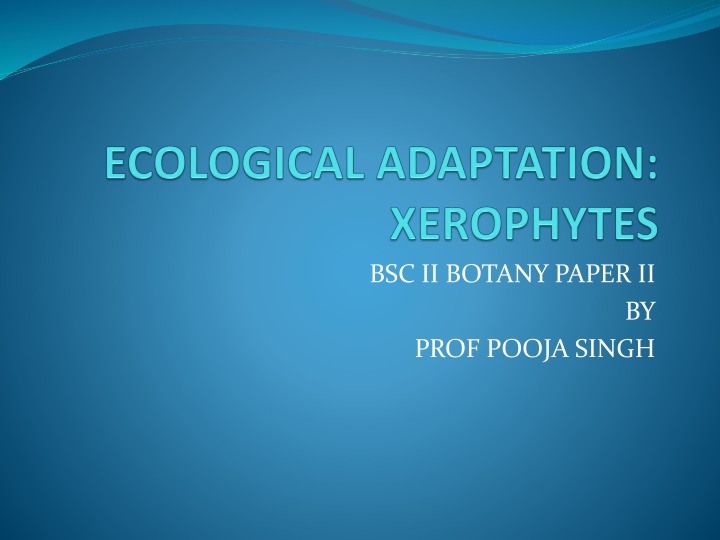
Xerophytes: Adaptations of Plants in Dry Habitats
Xerophytes are plants adapted to survive in dry habitats with limited water availability. They have specialized adaptations such as efficient water absorption and retention mechanisms, reduced transpiration rates, and low water consumption. Xerophytes can be grouped into drought-escaping, drought-enduring, and drought-resistant plants, each with unique characteristics. This adaptation is achieved through morphological, anatomical, and physiological changes in roots, stems, and leaves. Understanding xerophytic features and adaptations helps in appreciating the diversity and resilience of plant life in challenging environments.
Download Presentation

Please find below an Image/Link to download the presentation.
The content on the website is provided AS IS for your information and personal use only. It may not be sold, licensed, or shared on other websites without obtaining consent from the author. If you encounter any issues during the download, it is possible that the publisher has removed the file from their server.
You are allowed to download the files provided on this website for personal or commercial use, subject to the condition that they are used lawfully. All files are the property of their respective owners.
The content on the website is provided AS IS for your information and personal use only. It may not be sold, licensed, or shared on other websites without obtaining consent from the author.
E N D
Presentation Transcript
BSC II BOTANY PAPER II BY PROF POOJA SINGH
XEROPHYTES Plants which grow in dry habitats or xeric conditions are called xerophytes. Xeric habitats may be a. physically dry (less available water) b. physiologically dry (saline condition) Xerophytic adaptation accomplish To absorb as much water as they can get from the surroundings; To retain water in their organs for very long time; To reduce the transpiration rate to minimum; and To check high consumption of water
Xerophytes are grouped as: 1. Drought escaping plants- short life cycle, Examples (Papilionatae), some inconspicuous compositae (e.g., Artemisia) and members of families Zygophyllaceae, Boraginaceae, some grasses, etc. 2. Drought enduring plants 3. Drought resistant plants - true xerophytes, develop typical adaptations xerophytes can be divided into two groups which are as follows: 1. Succulent xerophytes. 2. Non-succulents, also called true xerophytes.
Xeric adaptations Xeromorphiccharacters- permanent, genetic Xeroplasticcharacters- induced by habitat Important xerophytic features are summarized under the following heads 1. Morphological (external) adaptations 2. Anatomical (internal) adaptations 3. Physiological adaptations
Morphological adaptations Roots :well developed root systems which may be profusely branched roots of perennial xerophytes grow very deep in the earth and reach the layers where water is available in plenty Root hairs are densely developed near the growing tips
Xerophytic stem Stems of some xerophytes become very hard and woody , may become subterranean They are covered with thick coating of wax and silica as in Equisetum, covered with dense hairs as is Calotropis. stems may be modified into thorns, e.g., Duranta, Ulex main stem itself becomes bulbous and fleshy , Kleinia articulata.
Stem modified into leaf-like flattened, green and fleshy structures which are termed as phylloclades. Muehlenbeckia In Ruscus plants, the branches developing in the axils of scaly leaves become metamorphosed into leaf-like structures, the phylloclades or cladophylls In Asparagus plant also a number of axillary branches become modified into small needle-like green structures, cladodes
Xerophytic leaves In some xerophytes the leaves, if present, are greatly caducous reduced to scales, as in Casuarina xerophytes have needle-shaped leaves, e.g., Pinus In leaf succulents, the leaves swell remarkably and become very fleshy owing to storage of excess amount of water , ex Aloe majority of xerophytes, leaves are generally much reduced and are provided with thick cuticle and dense coating of wax or silica
may be reduced to spines, as for example, in Ulex, Opuntia leaves of xerophytic species possess reduced leaf blades or pinnae and have very dense network of veins. Acacia phyllode leaves are covered with thick hairs which protect the stomatal guard cells and also check the transpiration , Calotropis extreme xerophyticgrasses have capacity for rolling or folding
Structure of xerophytic leaf of Ammophylla arenaria, showing protected stomata
Xerophytic anatomical modifications Heavy cutinisation, lignification s and wax deposition Multiple epidermis some of the epidermal cells that are found in the depressions become more enlarged than those found in the ridges. These enlarged cells are thin walled and are called bulliformcells or motor cells, facilitate the rolling of leaves by becoming flaccid during dry periods simple or compound, uni- or multicellular hairs surfaces of stems and leaves develop characteristic ridges and furrows or pits In xerophytes, number of stomata per unit area of leaf is greater than in Mesophytes. They are generally of sunken type. In some cases, they may be found in the furrows or pits
one or several layers of thick walled compactly grouped cells may develop that form the hypodermis, The hypodermal cells may sometimes be filled with tannin and mucilage. In the stem, a great part of body is formed of sclerenchyma In succulent stems and leaves, ground tissues are filled with thin walled parenchymatous cells which store excess quantity of water Intercellular spaces are greatly reduced In the leaves, mesophyll is very compact and the intercellular spaces are greatly reduced. Palisade tissue develops in several layers In succulent leaves, spongy parenchyma develops extensively which stores water Conducting tissues, i.e., xylem and phloem, develop very well in the xerophytic body.
Physiological Adaptations Succulents contain polysaccharides, pentosansand a number of acids by which they are able to resist drought, pentosans together with nitrogenous compounds of the cytoplasm cause accumulation of excess amount of water in the cells stomata open during night hours and remain closed during the day Some enzymes, such as catalases, peroxidases, are more active in xerophytes High osmotic pressure of cell sap
